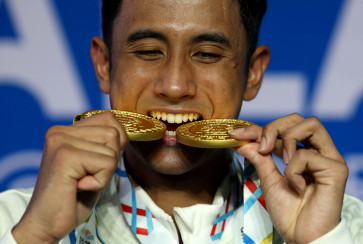Popular Reads
Top Results
Can't find what you're looking for?
View all search resultsPopular Reads
Top Results
Can't find what you're looking for?
View all search resultsRediscovering the vernacular
Courtesy of Robert Mondavi WineryFreedom is paramount to creativity, but discretion, carefulness and judicious decision-making must prevail if decent East-meets-West fusion food is to be crafted and paired with wine satisfactorily
Change text size
Gift Premium Articles
to Anyone
Courtesy of Robert Mondavi Winery
Freedom is paramount to creativity, but discretion, carefulness and judicious decision-making must prevail if decent East-meets-West fusion food is to be crafted and paired with wine satisfactorily.
This appeared to be the goal being pursued by Robert Mondavi Winery chef Jeff Mosher during the recent Robert Mondavi wine dinner at the Sriwijaya restaurant at the Dharmawangsa hotel in Jakarta.
The freedom to follow the general rule of pairing fish and white wine, for instance, was exercised in the first course (sauteed trevally and Robert Mondavi Napa Valley Fume Blanc 2012).
The freedom to defy it was on display in the main course, however, with spice-crusted yellow fin tuna paired with Robert Mondavi Napa Valley Cabernet Sauvignon 2012 and Cabernet Sauvignon Reserve 2001.
But what looked like two sides of pairing freedom was actually a well-known sauce-based logic. For the trevally (white in color, mild in taste), Mosher used a frenchified, light-tasting and sabayon-like coconut curry blend called Vadouvan, while for the tuna (red in color, bolder in taste), he used red wine vinaigrette.
Another freedom expressed in the dinner was evident in the absence of beef or lamb, despite the presence of two delicious red wines.
'I don't think it has to be that way; I love beef; I do beef,' Mosher said, 'but for this dinner I wanted to do something different'.
Doing 'something different' could be seen in his use of local fish for the first course, which he adorned with an interplay of colors. Instead of presenting salmon or other imported fish, he opted for fish Indonesians were familiar with: kuwe, a thick, nicely seared fillet set atop a colorful melange of foamy yellow Vadouvan and purple cauliflower puree made light-red by drops of lemon juice.
Although he can be as creative and free as he wants to be, his culinary creations were designed to catapult the wines.
The dishes he composed offered a fascinating expose of local food. The first course was Western-tasting kuwe, whose curry flavors had been judiciously scaled down.
The second course ' a bowl of rice noodles hidden under slow-cooked chicken thighs, paprika, eggplant and ginger scalion sauce ' tasted very much like its Chinese street food counterpart.
Although eggplant is not normally combined with Chinese noodle, the Chinese soy sauce, rice vinegar, sesame oil and coriander leaves mixed to make the dish taste unmistakenly Chinese. Presenting it on a fine dining table with a glass of Pinot Noir red wine was a bold statement of culinary freedom.
The main course (nutty medium-grain black rice from China mixed with slices of spice-crusted yellow fin tuna, baby shiitake, baby bok choy and watermelon radish) was a delightful, exciting assemblage of flavors somewhat reminiscent of local nasi campur (rice with an assorted mix of vegetables and meat/ egg).
Inside the rice I found, to my delight, a familiar and tasty puff-rice garnish known as rengginan in Javanese. Crusted with Jeff's version of togarashi blend (Japanese seven-spice mix), which included a little bit of chili, the tuna was cooked well-done on the outside and medium-raw on the inside, as if it were beef steak.
Chef Jeff Mosher works in Sriwijaya Restaurant kitchen. JP/Arif Suryobuwono
All these transformations, which Jeff intended to 'elevate local food', de-familiarized the familiar and familiarized the unfamiliar without, however, eclipsing the Napa Valley wines, which were all so delicious and flavorful that drinking them without food was a sheer pleasure.
The Fume Blanc (10 percent of which was Semillon) was brimming with gooseberry, fig and guava, refreshing with zesty acidity and subtly spicy, with hints of nutmeg.
The 2009 Pinot Noir was one of the best, most delicious New World Pinots I've ever tasted. Medium to full body with well-integrated oak, this Pinot bursted with a rich spectrum of savory ripe red fruit (strawberry and cherry) and subtle aromas of leather and smoke, but tightened up when left in the glass for a few hours.
The two Cabernet Savignon Reserves ' the 2012 (composed of 88 percent Cabernet Sauvignon, 6 percent Cabernet Franc, 4 percent Merlot, 1 percent Petit Verdot & 1 percent Malbec) and the 2001(composed of 88 percent Cabernet Sauvignon, 10 percent Cabernet Franc, 1 percent Malbec, 1 percent Petit Verdot) ' were enthralling New World reds.
The younger wine was concentrated yet fresh, fruity with well-integrated tannins, ripe black and red fruit interspersing with hints of dark chocolate, with good acidity with each sip.
The older wine was clean, smooth, deeper and earthier, with some minerality, sweet black fruit and dark chocolate notes synergizing, but when left sitting in a glass for a period of hours, began closing and showing signs of aging.
They were all made available in a perfect drinking-window for the dinner. This made it easier for Mosher to employ his self-restricted freedom to say more through a mixed Asian culinary language, one that led me to a serendipitious rediscovery of vernacular culinary treasures not commonly found in a formal fine-dining setting.












